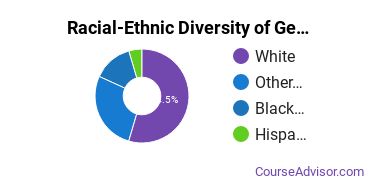General Psychology at Adler University
Every general psychology school has its own distinct culture and strengths. We've pulled together some statistics and other details to help you see how the psychology program at Adler University stacks up to those at other schools.Adler is located in Chicago, Illinois and has a total student population of 1,726.
Want to know more about the career opportunities in this field? Check out the Careers in General Psychology section at the bottom of this page.
Adler General Psychology Degrees Available
- Master’s Degree in Psychology
Adler General Psychology Rankings
Psychology Student Demographics at Adler
Take a look at the following statistics related to the make-up of the psychology majors at Adler University.
Adler General Psychology Master’s Program

The following table and chart show the race/ethnicity for students who recently graduated from Adler University with a master's in psychology.

| Race/Ethnicity | Number of Students |
|---|---|
| Asian | 0 |
| Black or African American | 0 |
| Hispanic or Latino | 3 |
| White | 4 |
| International Students | 0 |
| Other Races/Ethnicities | 3 |
Concentrations Within General Psychology
The following psychology concentations are available at Adler University. The completion numbers here include all graduates who receive any type of degree in this field from Adler University. Some of these focus areas may not be available for your degree level.
| Concentration | Annual Degrees Awarded |
|---|---|
| General Psychology | 22 |
Related Majors
Careers That Psychology Grads May Go Into
A degree in psychology can lead to the following careers. Since job numbers and average salaries can vary by geographic location, we have only included the numbers for IL, the home state for Adler University.
| Occupation | Jobs in IL | Average Salary in IL |
|---|---|---|
| Clinical, Counseling, and School Psychologists | 4,700 | $75,180 |
| Psychology Professors | 1,510 | $87,880 |
| Psychologists | 260 | $87,410 |
References
*The racial-ethnic minorities count is calculated by taking the total number of students and subtracting white students, international students, and students whose race/ethnicity was unknown. This number is then divided by the total number of students at the school to obtain the racial-ethnic minorities percentage.
More about our data sources and methodologies.
